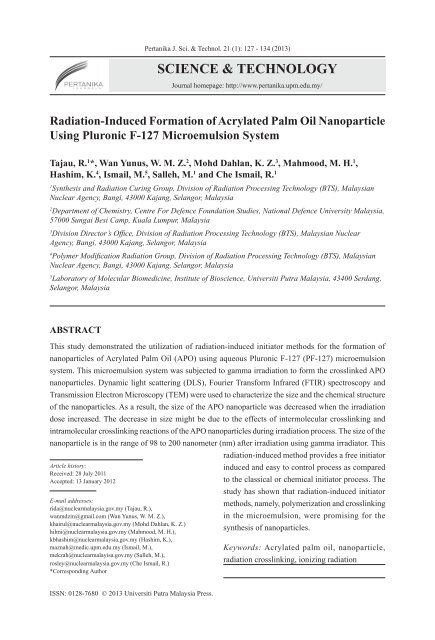JST Vol. 21 (1) Jan. 2013 - Pertanika Journal - Universiti Putra ...
JST Vol. 21 (1) Jan. 2013 - Pertanika Journal - Universiti Putra ...
JST Vol. 21 (1) Jan. 2013 - Pertanika Journal - Universiti Putra ...
Create successful ePaper yourself
Turn your PDF publications into a flip-book with our unique Google optimized e-Paper software.
ISSN: 0128-7680 © <strong>2013</strong> <strong>Universiti</strong> <strong>Putra</strong> Malaysia Press.<br />
<strong>Pertanika</strong> J. Sci. & Technol. <strong>21</strong> (1): 127 - 134 (<strong>2013</strong>)<br />
SCIENCE & TECHNOLOGY<br />
<strong>Journal</strong> homepage: http://www.pertanika.upm.edu.my/<br />
Radiation-Induced Formation of Acrylated Palm Oil Nanoparticle<br />
Using Pluronic F-127 Microemulsion System<br />
Tajau, R. 1 *, Wan Yunus, W. M. Z. 2 , Mohd Dahlan, K. Z. 3 , Mahmood, M. H. 1 ,<br />
Hashim, K. 4 , Ismail, M. 5 , Salleh, M. 1 and Che Ismail, R. 1<br />
1 Synthesis and Radiation Curing Group, Division of Radiation Processing Technology (BTS), Malaysian<br />
Nuclear Agency, Bangi, 43000 Kajang, Selangor, Malaysia<br />
2 Department of Chemistry, Centre For Defence Foundation Studies, National Defence University Malaysia,<br />
57000 Sungai Besi Camp, Kuala Lumpur, Malaysia<br />
3 Division Director’s Office, Division of Radiation Processing Technology (BTS), Malaysian Nuclear<br />
Agency, Bangi, 43000 Kajang, Selangor, Malaysia<br />
4 Polymer Modification Radiation Group, Division of Radiation Processing Technology (BTS), Malaysian<br />
Nuclear Agency, Bangi, 43000 Kajang, Selangor, Malaysia<br />
5 Laboratory of Molecular Biomedicine, Institute of Bioscience, <strong>Universiti</strong> <strong>Putra</strong> Malaysia, 43400 Serdang,<br />
Selangor, Malaysia<br />
ABSTRACT<br />
This study demonstrated the utilization of radiation-induced initiator methods for the formation of<br />
nanoparticles of Acrylated Palm Oil (APO) using aqueous Pluronic F-127 (PF-127) microemulsion<br />
system. This microemulsion system was subjected to gamma irradiation to form the crosslinked APO<br />
nanoparticles. Dynamic light scattering (DLS), Fourier Transform Infrared (FTIR) spectroscopy and<br />
Transmission Electron Microscopy (TEM) were used to characterize the size and the chemical structure<br />
of the nanoparticles. As a result, the size of the APO nanoparticle was decreased when the irradiation<br />
dose increased. The decrease in size might be due to the effects of intermolecular crosslinking and<br />
intramolecular crosslinking reactions of the APO nanoparticles during irradiation process. The size of the<br />
nanoparticle is in the range of 98 to 200 nanometer (nm) after irradiation using gamma irradiator. This<br />
Article history:<br />
Received: 28 July 2011<br />
Accepted: 13 <strong>Jan</strong>uary 2012<br />
E-mail addresses:<br />
rida@nuclearmalaysia.gov.my (Tajau, R.),<br />
wanmdzin@gmail.com (Wan Yunus, W. M. Z.),<br />
khairul@nuclearmalaysia.gov.my (Mohd Dahlan, K. Z.)<br />
hilmi@nuclearmalaysia.gov.my (Mahmood, M. H.),<br />
kbhashim@nuclearmalaysia.gov.my (Hashim, K.),<br />
maznah@medic.upm.edu.my (Ismail, M.),<br />
mekzah@nuclearmalayisa.gov.my (Salleh, M.),<br />
rosley@nuclearmalaysia.gov.my (Che Ismail, R.)<br />
*Corresponding Author<br />
radiation-induced method provides a free initiator<br />
induced and easy to control process as compared<br />
to the classical or chemical initiator process. The<br />
study has shown that radiation-induced initiator<br />
methods, namely, polymerization and crosslinking<br />
in the microemulsion, were promising for the<br />
synthesis of nanoparticles.<br />
Keywords: Acrylated palm oil, nanoparticle,<br />
radiation crosslinking, ionizing radiation





